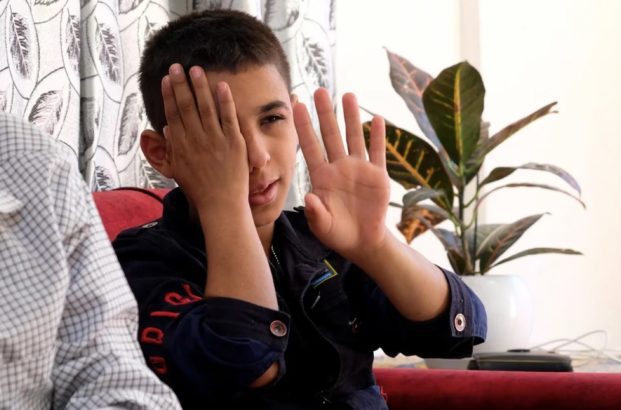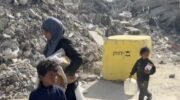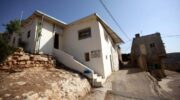Two Palestinian boys, aged 11 and 15, each lost sight in an eye after being shot by Israeli soldiers. The younger one has been denied entry into Israel to receive medical care because he is a ‘security risk.’ The older boy traveled to Jordan to try to save his eye.
by Gideon Levy and Alex Levac, reposted from Ha’aretz, September 16, 2022
They live a kilometer apart, have never met and probably never will. One is from a family of refugees and he lives in one of the grimmest, poorest and most crowded camps in the West Bank. The other, a few years older, lives with his mother and siblings in a relatively spacious home in an adjacent town.
The father of the former is the camp imam. The father of the older boy has been living in Houston, Texas, for the past four and a half years, in the hopes of improving his life and obtaining U.S. citizenship for himself and his family, and securing a future for his children. For the boy from the refugee camp, however, there is neither a present nor a future.
The main thing these two young people have in common, other than being Palestinians living under the Israeli occupation, is the sad fact that each of them recently lost sight in one eye after being shot by soldiers of the Israel Defense Forces. Safi Jawabra, the 11-year-old, lost his left eye; Ziad Abu Ayyash, 15, was shot in the right one.
Something else the two share relates to Ibrahim al-Nabulsi, one of Israel’s most wanted individuals until he was shot to death by Israeli security forces in Nablus on August 9. It was on that same day, during a demonstration protesting Nabulsi’s killing held in Beit Ummar, his town, that Ziad Abu Ayyash was wounded. For his part, Jawabra today wears a photograph of Nabulsi in a pendant dangling from a chain around his neck.
Al-Aroub evokes Gaza-like images of a refugee camp. Narrow alleys crowded with hordes of children after school, garbage rolling about in the streets, abject poverty, a hodgepodge of structures, with houses on top of each other, and jobless men, idle and listless. And as though all that weren’t enough, a fortified concrete IDF tower lords it over the camp, while troops man the checkpoints posted at each of Al-Aroub’s two entrances from Highway 60, between Bethlehem and Hebron.
Safi Jawabra lives on the second floor of a building at the far end of one of Al-Aroub’s narrow alleyways. It’s a meager home, whose entrance has also collected garbage, although a desperate attempt has been made to alleviate the drabness in the form of sofas of faded crimson velvet in the living room. Jawabra, dressed in fashionable jeans, is an appealing boy, with two dimples and a winning smile. He’s the youngest of seven in the family; it’s his father, Ahmed, 65, who is the local imam.
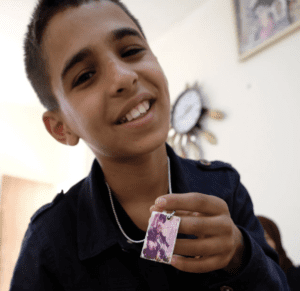
The youth is initially embarrassed when asked about the pendant and tries to hide it. But when we switch to other subjects, he turns out to be quite self-confident for someone his age, and answers our questions about why Ibraham al-Nabulsi is important to him. “He was a hero who fought the Israeli army bravely,” he replies in his soft voice.
Indeed, across the West Bank, children are wearing pendants with the portrait of the shahid – martyr – from Nablus.
On May 29, Jawabra, who is now in sixth grade, had a test in mathematics, after which he set out for home. There were confrontations in the camp at the time, between soldiers who had invaded it and young people throwing stones at them – an almost daily occurrence in Al-Aroub.
On the way home that day, Jawabra relates, he encountered such a clash.
The soldiers were shooting rubber-coated metal bullets and tear-gas grenades, and he says he was about 20 meters away from a group of them that had emerged from an ambush in a nearby alley. They fired in Jawabra’s direction and suddenly he felt a very painful blow to his face, as blood began flowing from one eye.
A relative who was on the street nearby carried the boy to a private car, which rushed him to a clinic in the nearby town of Beit Fajar. Jawabra says now that he didn’t cry, even for a minute. A Palestinian ambulance then evacuated him to Al-Hussein Governmental Hospital in Beit Jala, near Bethlehem, and from there he was taken to another local hospital. He underwent surgery there on a broken bone in his face.
Four days later, Jawabra was transferred to Jerusalem’s Hadassah University Hospital in Ein Karem, where doctors tried to save the sight in his left eye. They discovered that he was suffering from a torn retina. “The examination indicates a blunt injury, very serious, to the retina, with extensive commotio retinae [severe trauma to the eyeball], multiple areas of ischemia and a vitreous hemorrhage,” his hospital discharge letter states.
At this stage there wasn’t much that could be done for him, and he was released a minute before midnight on June 3, according to the letter.
Jawabra was asked to come back to Hadassah for follow-up treatment a month later. However, at checkpoint No. 300, outside Bethlehem, he was told that his father could enter Israel but he could not: He was on the Shin Bet security service’s “denied entry” list, the 11-year-old was informed. Following a series of phone calls, he was allowed in, but a month later, when an additional appointment had been scheduled, he was turned back at the same checkpoint and missed it.
A spokesperson for the Civil Administration, the Israeli authority that administers the West Bank, told Haaretz this week, declaiming the usual regulations: “The exiting of minors needs to take place with the accompaniment of a parent/guardian. Safi Jawabra is 11 and is denied entry on security grounds.”
With no other option, the youth is now under the care of an eye doctor in Bethlehem, Dr. Wahal Jabri. His evaluation is that there is nothing to do until Jawabra is 18; while the eyeball was not torn out, he barely sees anything with it, only shadows. The scar above his eye is a reminder of the operation he underwent to mend the broken bone in his face.
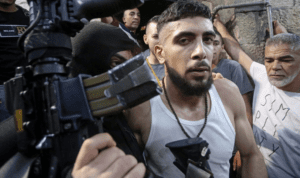
About a kilometer south of the refugee camp is the town of Beit Ummar, with its own armored IDF watchtower looming over it. The Abu Ayyash family, with six children, lives in a stone house here with fruit trees in the yard and a clutch of pine trees down the road. Ziad, a 10th-grader, wears glasses. About a month before he was wounded, his mother took him to an eye doctor, who prescribed them.
Now, ironically, his right eye is now half shut, red, sunken, blind; it will soon be replaced by an artificial eye. His mother, Asil, who’s 37, has blue eyes, the same color as her son’s. Her husband, Mohammed, owns a computer store in Houston and is waiting to receive a Green Card.

